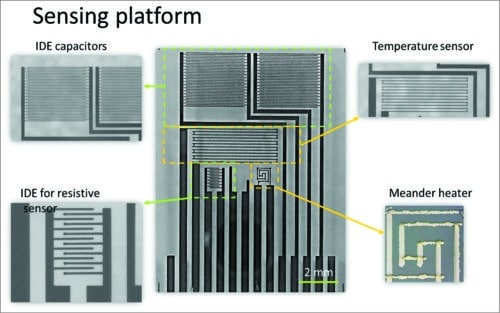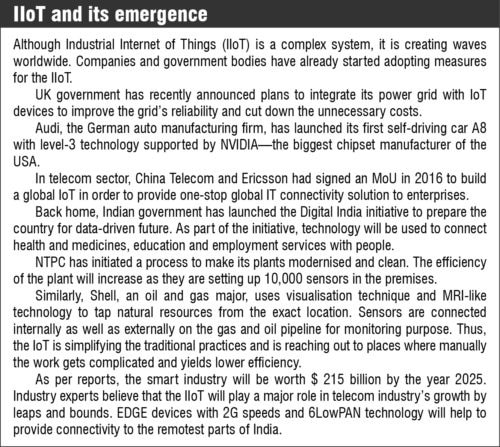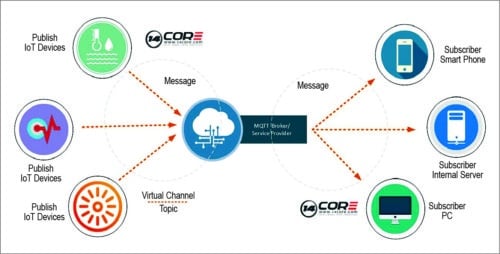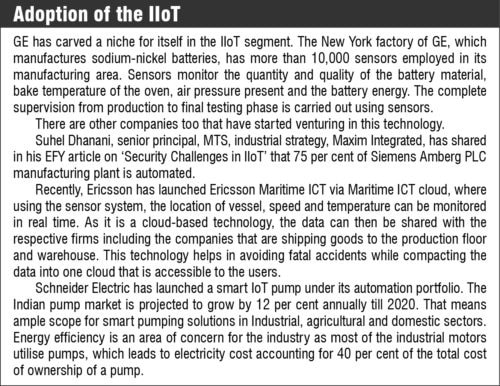There was a catastrophic incidence of oil spillage from the oil rigs in Gulf of Mexico in April 2010. The drilling rig ‘Deepwater Horizon’ had spilled about 185 million gallons of oil into the sea, endangering breeds of marine creatures. Later, forensic reports proved that a puncture in the pipe due to oil and gas pressure had created the havoc. Had there been a smart automation system in place, the fault would have been detected at an early stage, hence avoiding the mishap.
This incident highlights the necessity of smart automation in industries. And as it is said “necessity is the mother of disruption,” the dire need of a safe, secure and efficient industrial system gave birth to the Industrial Internet of Things or IIoT.
The IIoT roadmap
There was a time in the 18th century when industrial machines were powered by steam. Industry 2.0 was powered by electric energy and industry 3.0 went autonomous. Now we have industry 4.0, which runs on cyber-physical systems.
This paradigm shift of the industry norms from manual to smart automation is helping to remotely monitor and control every part of the industrial facility.
“Later, five considerations were taken for enabling IIoT—distributed intelligence, rapid connectivity, establishing open standards and systems, real-time context integration and autonomous production lines,” says Narendra Sivalenka, senior manager-IoT team, Cyient.
Extracting data from all systems or extricating data from the main system and placing it into different machines in perfection is the distributed intelligence in the IIoT. This data is then connected with each other in a network after integration. Later, as per customer needs, this data is extracted in a smart way to avoid monotony of work, maximise throughput and minimise labour cost.
Technology behind the IIoT
Hardware components of the IIoT include sensors, RFID, condition monitoring, distributed control systems (DCS), smart meters, camera system, industrial robotics, AHS and networking technologies. Product lifecycle management (PLM) systems, manufacturing execution systems (MES) and supervisory control and data acquisition systems (SCADA) are the software parts.
Processor technology, artificial intelligence, DRAMs and memories, and virtual and augmented reality are fields of the IIoT where something exciting is happening on a regular basis.

Driving circuit
As mentioned in ‘Industrial Developer Boards’ article of July issue, these boards are undergoing a complete technology change. These find various IIoT applications including robotics, automotive manufacturing, power grids and many more.
The RF based detector in industrial developer boards allows 3D mapping of objects using time-of-flight concept. Thus, antennae are embedded in the system itself, making the board condensed while reducing processing time. Such industrial developer boards are beneficial for robotics.
Footprint reduction of FPGAs, antennae and other critical components is creating a boom in the industrial IoT segment. Reducing the component size not only helps in reducing the manufacturing costs but also in thermal suppression. Be it the power supply section for a developer board serving the pick-and-place machine or a developer board for smart lighting, thermal dissipation is considerably low.
For applications like motor drives, machine-to-machine communication and smart grids, real-time processing and analysis, longevity, warranty and flexibility are key factors that make industrial boards the preferred option over normal boards. Typically, these can withstand industrial temperatures ranging from –40 degrees to 80 degrees centigrade. There are also a few developer boards meant for ovens, which can withstand temperatures of more than 300ºC.
Sensor integration allows a device to perform several functions. For instance, automobiles are now well-equipped with Bluetooth, Wi-Fi, indicators, odometer, fuel indicator, theft alarm and many such features.
Similarly, infotainment system, cluster, automotive and automotive advanced driver assistance are now integrated on a single MCU, thus reducing the wire harnessing and simplifying the anatomy of cars, making them safer as well as far more efficient.
In these cases, developer boards are designed to integrate a number of functions, which helps to reduce the design costs and space requirements.
Smart camera and imaging system
Similarly, imaging is no longer restricted to laboratories only. It is now gaining significance at the industrial level as well.
A leading automobile manufacturing company employed a robotic arm for automation, which was used to detect the objects to pick and assemble only at a spatial frame and angle. But, even if there was no work, the robotic arm continued to move, which reduced its service life and wasted electricity.
Now, with smart automation, robots can easily identify objects in 3D space too. This is particularly helpful for the automation segment, where robot arms could identify the objects to be picked and placed in a single direction only. Thus, 3D vision is making manufacturing smarter, saving time, electricity and human efforts.
New measuring techniques have come up for the automotive industry’s paint lines, which combine deflection in 3D and 2D surface inspection. This technology in cameras controls the quality 100 per cent and the inbuilt sensors deliver precise automated results in real time.
Experts believe that in future, with battery-managed electrical vehicles, the necessity to keep a check on foreign bodies, rough cuts and splits will increase. Enhanced efficiency, reliability, clarity and fast process are just some of the reasons to upgrade the imaging system not only in electrical vehicles but also in mobile communication networking as we move ahead to 5G technology.

DRAMs becoming smart
When we consider upgrades in IIoT implementation, DRAMs are a unique trendsetter.
Sivalenka states, “The 3D chip technology has converted to mainstream and for high capacity and performance, the industry is heading towards 3D DIMM RAM. The higher the bandwidth memory, the higher is the storage-on-chip and the wider the bus possible with off-chip memory.”
Smart networking protocols
ZigBee, Lora WAN, Ethernet protocol and Bluetooth 5.0 are some of the smart networking protocols that are implemented in smart lighting, smart energy and smart automation systems.
ZigBee Pro wireless network can support up to 2.4GHz band for the IoT. This flexibility and connectivity can be used in streetlight application. The wider the bandwidth, the greater the number of devices or lights that can be connected to each other in a long-range frame.
Due to the increasing bandwidth of networking protocols used in smart lighting, wireless technologies are also making way to high-end developments using Bluetooth, Wi-Fi and Li-Fi technologies. In the lighting field itself, the annual growth rate is anticipated up to 25 per cent.
Protocols coming up
“Although companies have adopted protocols such as MQTT, Rest, MT-connect, object management group and OPC-UA, with the rising security concerns for connected devices there is an urgent need for establishing uniformly recognised global standards for both communication and security protocols,” shares Vinay Nathan, CEO, Altizon.
MQTT, short for ‘message queue telemetry transport,’ is an ISO standard designed for remote locations where the bandwidth is limited. This message protocol is used on top of TCP/IP protocol, to support wireless networks with varying levels of latency due to unreliable connections.
For instance, for measuring temperatures globally and creating a database where one can see the history, MQTT has a solution known as Wildcards. This solution can be used for any location (even customised areas), irrespective of the country.
When it comes to productivity, manufacturers can use open and free source standards to develop customised systems for their processes. Here, MT-connect protocol is a boon for the IIoT. It can be used to extract data from the controller and perform pattern recognition for monitoring the health condition of spindle and machine tool axes.

Object Management Group is helping with IIoT standardisation across the globe. Data Distribution Service (DDS), Systems Modeling Language (SysML) and Interaction Flow Modeling Language (IFML) are contributing to improve the productivity, cut costs and streamline processes of the IIoT.
IIoT no longer a hype
Earlier, the IIoT was an application that required lots of capital investment. So only up to 15 per cent of industrial assets was converted into digitised data. Now, as enterprises aim to lower sensor costs and change the route of sensor application, the IIoT is said to convert assets up to 35 per cent.
Initiatives have been taken in European countries like Germany and France to promote implementation of the IIoT on a big scale. Countries like USA, India and China are also deploying smart manufacturing technologies to increase their national GDPs. Schneider Electric has recently expanded its automation portfolio in India with the launch of IoT-enabled smart pumping solutions, which asserts that the IIoT is no longer a hype.
IIoT and smart applications
From smart dust to drones, futuristic farming to energy networks, motor control to machine-to-machine, IIoT applications are creating a web across the globe.
Motors are a generic element of the manufacturing industry. So their efficiency, reliability and power consumption need to be taken care of. FPGA ICs exhibit long-term reliability and long lifecycles, supporting the working of motors for long hours.
Similarly, there are devices that support the powerful Ethernet-based protocol for real-time communications.
5G is the latest trend, which has left 2G, 3G and 4G behind. This technology is evoking the interest of key industry players due to its higher bitrate, lower latency and extended bandwidth. For instance, smart cars and intelligent mobility systems largely depend upon 5G and the IoT. Smart cars provide sophisticated features such as infotainment, communications, diagnostics and driver assistance. Fully automated vehicles are still far off, yet some manufacturers are providing smart features like parking assistance and crash avoidance.
According to research reports, by year 2020, connected cars will account for up to 75 per cent of the worldwide shipments, which is quite large compared to the present scenario. And embedded systems will account for 40 per cent of the material cost of these complex vehicles.
While we cite out smart cars, there is a co-operative systems innovation in Europe which is a part of intelligent mobility systems. The city circuit is a venture of service providers like automotive supply chain, road transport and digital industries engaged in development and testing of vehicles integrated with their environment.
Obstacles
The Deutsche Bank estimates that in industrial-level automation, the level of efficiency, accuracy and reliability achieved with the IIoT increases the productivity by 30 per cent. Still, some industries in India look at the IIoT as a separate business segment where they need to spend money on sophisticated things.
There are other reasons too. In case of critical machinery control, there is a high possibility of failure if timings of the control signals mismatch. So, there needs to be a safe and secured networking system for communication between systems even miles apart.
Moreover, there is a requirement of flexible hardware, software and networking platforms that are capable enough to be in-sync with each other.
With the sophisticated network comes the responsibility of data handling and security. Lots of machinery is required to connect with each other and derive data from functions. Data being very large, it needs to be clubbed in a single cloud-based system. This cloud-based system should be tightly secured so that only registered users can extract the company’s factory automation data.
It is foreseen that by 2020, companies will spend roughly above $1.5 trillion a year on the IIoT. As many as 96 per cent of industrialists expect an increase in the number of attacks on the IIoT in 2017. So leading companies have created some protocols to plan a tightly secured IIoT system. From understanding the concerns to studying the attack trends, from evaluating the risk of blending IT and OT to considering the devices and gateways, some best practices have been initiated by the experts.

Future outlook
Nathan says, “The IoT is making big strides due to new advances on both hardware and software fronts. On the hardware side, printed flexible sensors are the future of technology for the IIoT. These sensors are lightweight and low-cost, which will be a critical evolution for the field. On the software front, edge computing is proving to be a game changer by allowing cloud-based machine learning models to be pushed to distributed machine environment, thereby making hardware more intelligent, fast, and reliable.”
Also, edge computing would be implemented to push intelligence to the edge.
Sensors ranging from optical and temperature to piezoelectric, and gas and humidity sensors will all be printed on flexible substrates, representing a growing market. This is a technology forecast for the period 2017-27, when major players will shrink the size of sensors to increase their number in a unit, thereby increasing the number of functions it can perform. With properties like mechanical flexibility, thinness and weightlessness, flexible sensors are all set to break the barriers of commercialisation.
Edge computing technology has become a common framework that builds an ecosystem for plug-and-play of components in a system through simplification and standardisation. Thus, it makes interoperability between devices, applications and services possible.
Experts envision the future of the IIoT as one which would deal in security solutions for the IIoT and deploy millions of devices connected to each other. We cannot wait any longer for a single concept of the IIoT that would connect millions of devices worldwide, thereby enabling just one organisational culture for all nations.






